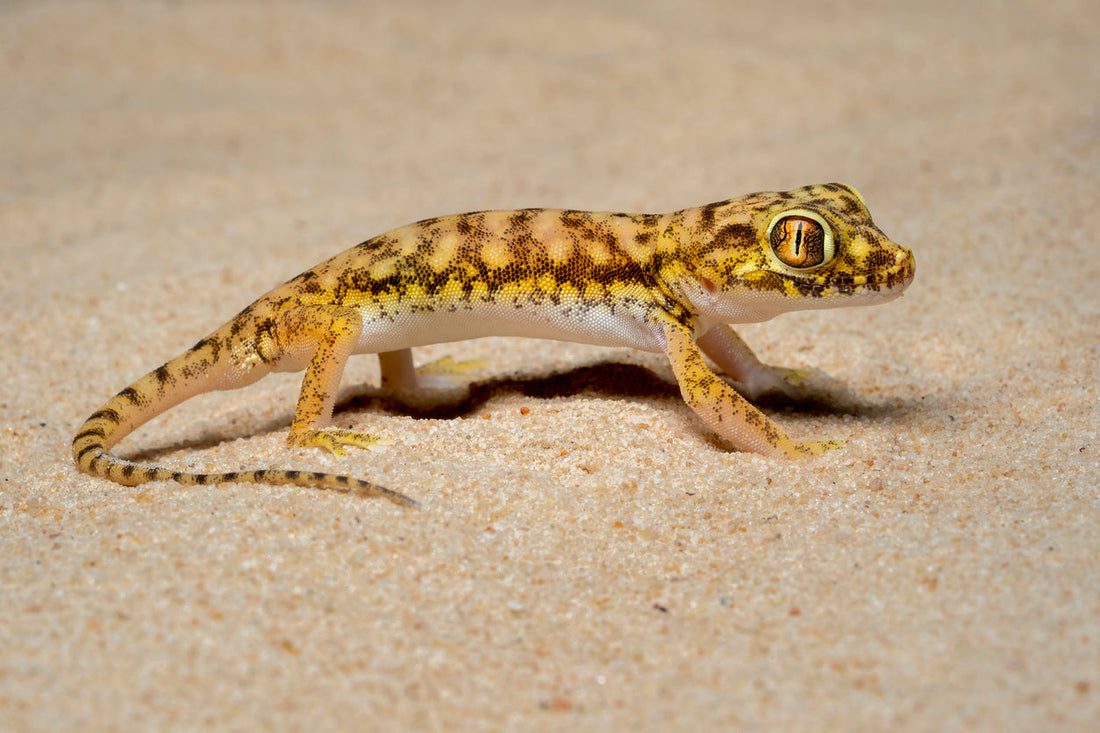Dune Gecko (Stenodactylus spp.) Care Sheet
Quick Facts
Scientific Name: Stenodactylus spp.
Common Names: Dune Gecko, Desert Gecko
Origin: North Africa and the Middle East
Adult Size: 7–12 cm (3–5 inches) total length
Lifespan: 6–10 years in captivity
Sex Differences: Males are generally slimmer with slightly larger heads; females are rounder and more robust-bodied
Beginner Suitability: Moderate – hardy species but require careful humidity and temperature management
Enclosure
Size: A single adult can be housed in 30 cm x 30 cm x 30 cm (12 x 12 x 12 inches), but larger enclosures are preferred. Juveniles can be housed in smaller enclosures (20 cm x 20 cm x 20 cm).
Substrate: Use a sand-soil mix (50–50) or fine sand with a top layer of flat stones for burrowing and hiding. Avoid substrates that can cause impaction.
Hides: Provide at least two hides—one on the hot side and one on the cool side. Include rocks or cork bark for naturalistic hiding.
Heating: Maintain a hot spot of 28–32°C and a cool side of 22–25°C. Night temperatures can drop to 18–20°C. Use ceramic heat emitters or under-tank heating pads with a thermostat.
Lighting: UVB is optional but low-level UVB (2–5%) can be beneficial. Maintain a 12-hour light / 12-hour dark cycle.
Humidity: Maintain 20–40% ambient humidity. Provide a shallow water dish and mist lightly if needed. Ensure proper ventilation to prevent mould or respiratory issues.
Diet
Primary Diet Type: Insectivore
Food Items: Feed small gut-loaded insects such as crickets, locusts, and small roaches. Hatchlings require smaller prey, while adults can take larger insects.
Feeding Frequency: Hatchlings daily. Juveniles every other day. Adults every 2–3 days.
Feeding Troubleshooting: Ensure insects are appropriately sized (no larger than the width of the gecko’s head). Dust insects with calcium at every feeding and a multivitamin once per week.
Water
Provide a shallow water dish with clean water at all times. Dune Geckos may also drink droplets from misted surfaces.
Behavior And Handling
Dune Geckos are generally skittish and fast-moving. Handle with care and support the full body. Avoid handling juveniles frequently to reduce stress. They are solitary and should be housed individually.
Enrichment
Provide rocks, cork bark, and substrate for burrowing. Include multiple hides and occasional rearrangement of décor to encourage natural exploration.
Health
Signs of illness include lethargy, refusal to eat, abnormal stool, retained shed, or swelling. Maintain proper temperature, humidity, and diet. Consult a reptile-specialist veterinarian if issues persist.
Lifespan
Typically 6–10 years in captivity, with proper care and husbandry.
Legality In The UK
Dune Geckos are legal to keep in the UK. No licence is required for private ownership. Owners must comply with Welfare of Animals regulations.
Difficulty Bars (Relative)
| Category | Level |
|---|---|
| Feeding | ███▁▁ Moderate (requires gut-loaded insects and supplement dusting) |
| Handling | ███▁▁ Moderate (skittish, handle carefully) |
| Humidity Needs | ███▁▁ Moderate (maintain 20–40% with misting) |
| Enclosure Setup | ████▁ Moderate (temperature gradient and hides essential) |
| Beginner Suitability | ███▁▁ Moderate (good for experienced keepers) |

